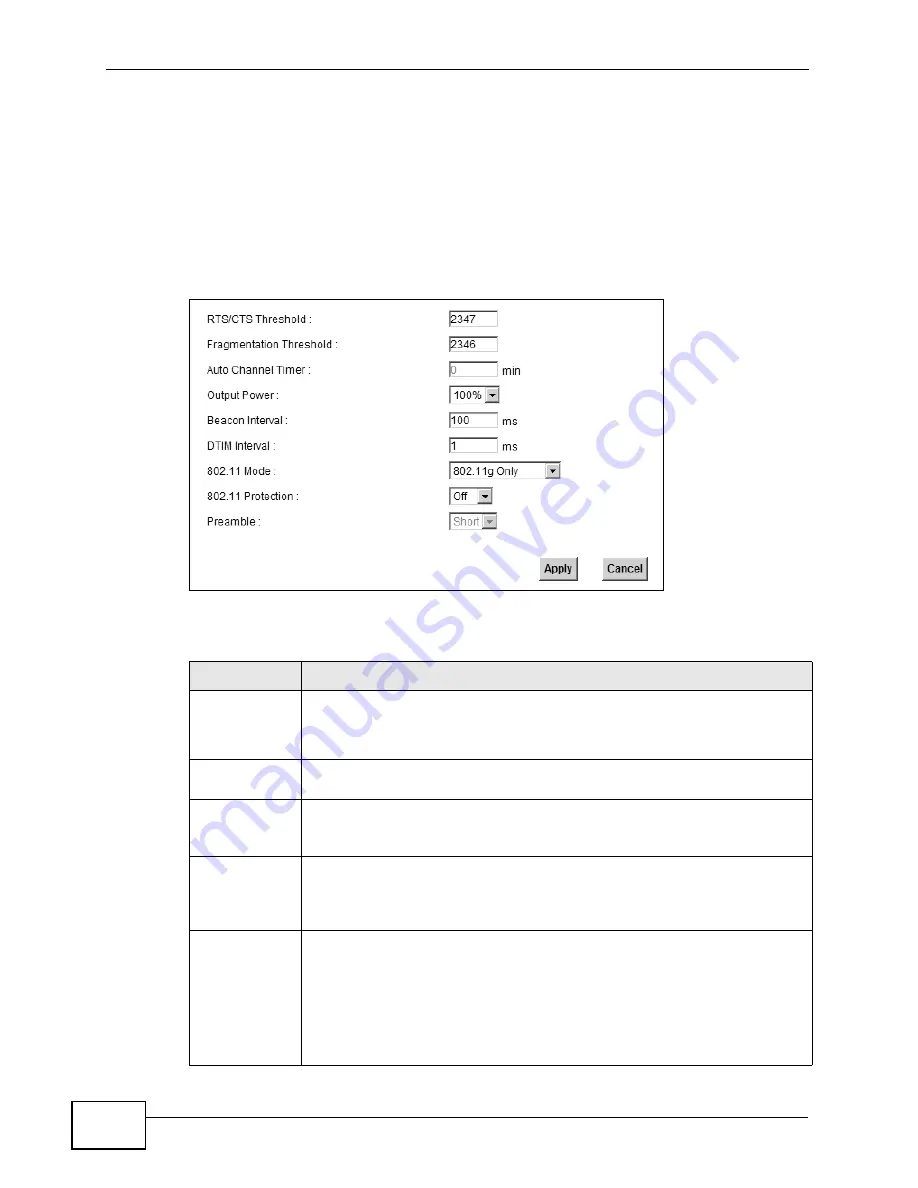
Chapter 7 Wireless
VSG1432-B101 Series User’s Guide
110
7.8 The Others Screen
Use this screen to configure advanced wireless settings. Click
Network Settings
> Wireless > Others
. The screen appears as shown.
See
Section 7.9.2 on page 113
for detailed definitions of the terms listed in this
screen.
Figure 35
Network Settings > Wireless > Others
The following table describes the labels in this screen.
Table 21
Network Settings > Wireless > Others
LABEL
DESCRIPTION
RTS/CTS
Threshold
Data with its frame size larger than this value will perform the RTS
(Request To Send)/CTS (Clear To Send) handshake.
Enter a value between 0 and 2347.
Fragmentation
Threshold
This is the maximum data fragment size that can be sent. Enter a value
between 256 and 2346.
Auto Channel
Timer
If you set the channel to
Auto
in the
Network Settings > Wireless >
General
screen, specify the interval in minutes for how often the ZyXEL
Device scans for the best channel. Enter 0 to disable the periodical scan.
Output Power
Set the output power of the ZyXEL Device. If there is a high density of
APs in an area, decrease the output power to reduce interference with
other APs. Select one of the following:
20%
,
40%
,
60%
,
80%
or
100%
.
Beacon
Interval
When a wirelessly networked device sends a beacon, it includes with it a
beacon interval. This specifies the time period before the device sends
the beacon again.
The interval tells receiving devices on the network how long they can wait
in low power mode before waking up to handle the beacon. This value
can be set from20ms to 1000ms. A high value helps save current
consumption of the access point.
Summary of Contents for VSG1432-B101 - V1.10
Page 2: ......
Page 8: ...Safety Warnings VSG1432 B101 Series User s Guide 8 ...
Page 10: ...Contents Overview VSG1432 B101 Series User s Guide 10 ...
Page 20: ...Table of Contents VSG1432 B101 Series User s Guide 20 ...
Page 21: ...21 PART I User s Guide ...
Page 22: ...22 ...
Page 40: ...Chapter 2 The Web Configurator VSG1432 B101 Series User s Guide 40 ...
Page 67: ...67 PART II Technical Reference ...
Page 68: ...68 ...
Page 74: ...Chapter 5 Network Map and Status Screens VSG1432 B101 Series User s Guide 74 ...
Page 146: ...Chapter 8 Home Networking VSG1432 B101 Series User s Guide 146 ...
Page 150: ...Chapter 9 Static Routing VSG1432 B101 Series User s Guide 150 ...
Page 174: ...Chapter 11 Policy Forwarding VSG1432 B101 Series User s Guide 174 ...
Page 192: ...Chapter 12 Network Address Translation NAT VSG1432 B101 Series User s Guide 192 ...
Page 198: ...Chapter 13 Dynamic DNS Setup VSG1432 B101 Series User s Guide 198 ...
Page 224: ...Chapter 16 Firewall VSG1432 B101 Series User s Guide 224 ...
Page 230: ...Chapter 18 Parental Control VSG1432 B101 Series User s Guide 230 ...
Page 278: ...Chapter 25 Traffic Status VSG1432 B101 Series User s Guide 278 ...
Page 282: ...Chapter 26 IGMP Status VSG1432 B101 Series User s Guide 282 ...
Page 290: ...Chapter 28 Remote Management VSG1432 B101 Series User s Guide 290 ...
Page 294: ...Chapter 29 Time Settings VSG1432 B101 Series User s Guide 294 ...
Page 298: ...Chapter 30 Logs Setting VSG1432 B101 Series User s Guide 298 ...
Page 314: ...Chapter 34 Troubleshooting VSG1432 B101 Series User s Guide 314 ...
Page 344: ...Appendix A Setting up Your Computer s IP Address VSG1432 B101 Series User s Guide 344 ...
Page 354: ...Appendix B IP Addresses and Subnetting VSG1432 B101 Series User s Guide 354 ...
Page 380: ...Appendix D Wireless LANs VSG1432 B101 Series User s Guide 380 ...






























